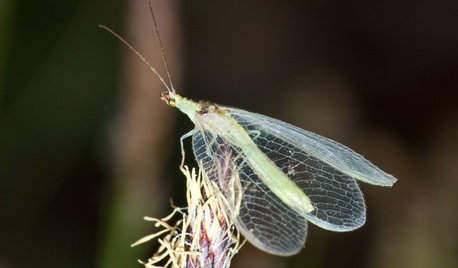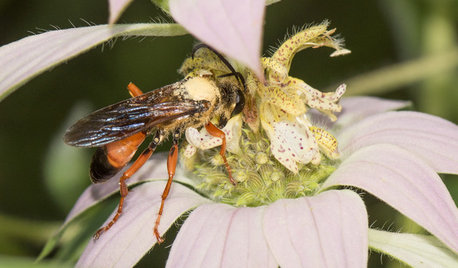Everyone seems to be having a lot of trouble with pests this year. Here's some information I hope helps.
After a lifetime of gardening, I have learned that all insects are not bad and that many are good. Many are good because they help control the bad bugs that damage plants. If you spray a multi-purpose general insecticide, whether it is organic of synthetic, you will kill off the good bugs as well as the bad ones. The good bug population is always slower to rebound because there has to be a large enough population of bad bugs to feed the good ones before the good ones will begin significant reproduction.
I also have learned that STRESSED plants are more likely to suffer from serious bug infestations. Therefore, you have to address whatever is stressing the plants. I would like to point out that anything growing in Oklahoma tends to be stressed by the weather, and you can't control the weather, but you can try to mitigate its effects.
Organic gardeners must tolerate some pest populations over the long haul in the garden. That is just the way it is. There are no easy answers. To successfully garden organically, you have to manage your entire gardening system to provide the least plant stress possible and to encourage good bugs and discourage bad bugs. This involves a lot of diverse activity:
1. Accept that there will always be a certain level of insect damage.
2. When planning the garden, carefully select pest- and disease-resistant varieties of plants. For example, Silver Queen corn is one variety of corn that seems to resist corn earworms especially well. Research and learn what plants resist the pests that bug you, and use them.
3. Enrich your soil by adding organic matter. Organic matter encourages beneficial microorganisms which gives you healthier, less stressed plants. Less stressed plants resist pest damage.
4. Plant companion plants to encourage good bugs and discourage bad bugs. Companion planting is both an art and a science, but I believe it works.
5. Rotate vegetable crops and annual flower or foliage plantings from one spot to another each year to interrupt the pest reproduction cycles. For example, if you always grow potatoes in the same spot, potato bugs will reproduce and return to that same spot every year. Rotation is just one way to confuse and defeat the potato bugs.
6. Use insect traps to monitor and control pest populations early before they get out of hand. Various forms of traps are available from organic supply companies like Gardens Alive and many others.
7. Use floating row covers in the vegetable garden to protect susceptible crops during periods of heavy pest emergence or migration. You can use sticky yellow traps to attract and trap many pests. Tanglefoot is a product that you can apply to trees for this purpose in some instances. Various homemade cutworm collars can virtually halt the loss of seedlings and young plants to cutworms.
8. Encourage the beneficial insects which prey upon the harmful insects. This is complicated. It sometimes involves purchasing helpful insects like ladybugs, green lacewings, parasitic wasps, beneficial nematodes and spider mite destroyers/predatory spider mites. Ladybugs, for example, are not at all expensive but predatory spider mites are incredible expensive, so you have to decide how much you are willing to spend and also if it is cost-effective to do so.
You cannot spray ANY multipurpose insecticide and expect to have beneficial insects around.
You can encourage beneficials by planting companion plants that attract them. It isn't hard at all.
Using beneficial insects to control harmful insects is the single most important thing I do in my garden and home landscape. I love it because it works. It IS NOT a quick fix though, taking us back to that old saying "There Ain't No Such Thing As A Free Lunch".
Using beneficial insects takes time, constant effort and some money. It does involve working WITH nature instead of AGAINST it and that is very important to me. It involves studying your garden and landscape, understanding which bad insects appear when, and knowing which beneficials will combat them. It involves encouraging those beneficials, doing nothing to harm them, and giving them time to do their job. It involves patience above all else.
Take aphids for example. Aphids are very damaging to plants and also carry and spread diseases, some of which can be devastating to your plants. So, when you see aphids, it is a cause for real concern. How you direct that concern is important. If you panic and spray any insecticide, whether synthetic or organic, you will kill that round of aphids, but you will also kill the beneficial lady bugs who were going to get them under control. It is better, and wiser, and harder, to stay calm, look for the beneficial lady bugs, buy and release them if you don't have them after the aphids have been there a few days, and let the ladybugs do their job. With any luck at all, the ladybugs will reproduce and control many pests from that point on.
Every time you have a pest bug in the garden, you have to research and figure out what it is. Only then can you decide what to do about it. Some bugs are sort of a one-shot deal. They do their damage and move on. With that sort of pest, by the time you see the damage, it is too late to do anything to prevent it and, since the bugs already have moved on or soon will be moving on, you just ignore the damage and get over it.
9. When you see a problem insect on ANY plant, whether it is a tree, shrub, vine, perennial, annual, fruit, veggie or whatever, ask yourself WHY that pest is on that plant? Is the plant stressed? Plants that are in poor soil or that need to be fed/fertilized are much more susceptible to pests that those that are in good soil and are PROPERLY fed. However, plants that are OVER-FERTILIZED, especially with excess nitrogen, are also stressed and very attractive to damaging insects, so remember that balance is important.
10. To avoid losing a whole row of plants to insect infestations, avoid planting in rows or swaths. I know that is hard, especially in a veggie garden, but it is important. For example, if you have a row of tomato plants with nothing in between, the tomato fruitworms, stinkbugs and spider mites will move easily from plant to plant. If you interplant tomato plants with herbs and companion plant with flowers that attract good bugs, the pest bugs have to navigate through the other plants to find another tomato plant and also have to contend with the benficial insects as they do so. The same thing is true with trees, shrubs and flowers that are susceptible to a particular pest.
11. Encourage other bug-eaters around the landscape, including toads and frogs, birds, lizards and non-venomous snakes. You can do this by providing small pans or saucers of water for them to drink from, or a small wildlife pond....even one that is only a few square feet. You can feed the birds year-round to attract them to your garden, but be especially sure to feed them in the winter. My garden is always full of birds. They tend to ignore the birdseed and go for the bugs as long as there are bugs to eat.
12. Mulch, mulch, mulch. The use of mulch does much more than hold moisture in the soil. It prevents soil splash that can carry fungal, bacterial and viral diseases up onto the foliage of plants which stresses them. It gives beneficial insects a place to hide and wait for the bad bugs. It feeds the soil as it breaks down, so you will have to add new mulch periodically. Mulch especially attracts earthworms and they are very beneficial in the soil.
Some of the most desirable insects in the garden are lady bug larvae and lacewing larvae which will feed on aphids, parasitic wasps which will feed on aphids, grub worms and caterpillars (both good and bad), ground beetles which feed on a multitude of ground-dwelling pests and many forms of robber flies and hover flies which eat lots of various insects, including leafhoppers. To learn more about beneficial insects you can google the term 'beneficial insects' or check out the website of one of the many companies that supplies them, like Arbico or Gardens Alive
Keep in mind that you can't just buy and release beneficials. You have to provide them with plants that feed and shelter them at various stages in their lives. I interplant my veggie crops with flowers and herbs that serve this purpose. I also have mixed borders of trees, shrubs, perennials, annuals, vines, and ground covers that serve this purpose. Diversity is very important.
In general, the ground beetles will shelter in mulch underneath low-growing plants of any kind. They especially like herbs such as mint, rosemary and thyme that grow low to the ground. Many beneficials are attracted to plants with TINY flowers, like sweet Alyssum, Fennel, Dill, Yarrow, Queen Anne's Lace, Tansy, Cilantro IF let go to seed, rue, angelica, clovers, etc. All these tiny-flowered plants are especially attractive to parasitic wasps. Daisy type composite flowers like zinnias, cosmos and chamomile, among many others, attract predatory wasps too as well as robber fies and hover flies.
I grow many, many herbs in the vegetable gardens and mixed borders to attract beneficial insects and/or repel undesirable ones.
Nasturtiums deter aphids, bean beetles, squash bugs and other undesirable bugs. I plant nasturtiums everywhere, even in containers that have tomato plants or pepepr plants in them.
Tansy repels ants, cabbage moths, japanese beetles, other beetles, squash bugs and flies.
Calendula, aka pot marigold, repel asparagus beetles, which are very hard to control. They also repel tomato hornworms if interplanted with your tomatoes.
Chives repel aphids.
Cilantro/coriander (same plant--if harvested in leaf form it is cilantro, if harvested later in leaf form it is coriander) repels aphids especially if allowed to flower.
Borage repels tomato hornworms if interplanted with tomatoes. As a bonus, this herb has lovely blue flowers and is attractive to many beneficial insects.
Marigolds repel bean beetles if planted near your beans. There is a form of marigolds that can be planted and tilled into the soil to aid with root-knot nematodes, but you have to plant them and till them into the soil a year before you plant a crop into that area.
Rosemary repels cabbage moths, bean beetles, carrot flies, mosquitoes, and other pests.
Basil repels flies and mosquitoes and is said to improve the flavor of tomatoes if grown near them.
Oregano repels cabbage moths.
Catmint and catnip both repel flea beetles.
Horseradish repels potato bugs but is invasive, so plant carefully.
Rue repels flies and japanese beetles.
Sage repels cabbage moths,carrot flies and other insects.
Thyme repels cabbage moths.
Mints repel cabbage moths and flea beetles but are invasive, so plant with care.
Hyssop repels cabbage moths and attract beneficials when it flowers.
Southernwood/Artemisia repels both cabbage and fruit tree moths. So does santolina.
Lavendar is said to repel ticks, moths and mice. I wash my dogs with Dr. Bronner's Lavedar Soap and Peppermint Soap. The aroma of both soaps seems to repel ticks and fleas on the dogs.
I'll write about some common organic garden pesticides in a separate post in a little while. My brain and my fingers are tired and I need to go turn the poultry loose to free-range.
Dawn














wolflover
Okiedawn OK Zone 7Original Author
Related Discussions
insect control on beans
Q
Beneficial insects and other organic thrip control
Q
Insect control
Q
organic grasshopper control
Q